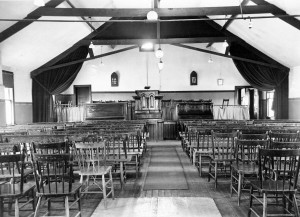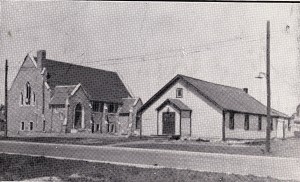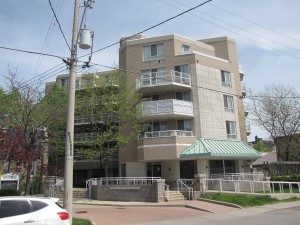Riverdale Presbyterian Church
It is difficult to know how to determine the age of a congregation. Although it grew out of a much older ecumenical (Presbyterian, Baptist, and Anglican) Sunday school on Jones Ave., Riverdale’s life as a distinct Presbyterian entity on Pape Ave. began in a chain of events in the years 1906, 1907, and 1908. The first meeting of the exclusively Presbyterian Sunday school was held in a tent in the middle of an orchard at the corner of Pape Ave. and Harcourt Ave. on September 26, 1906. Nearly a year later, on August 4, 1907, Riverdale became an “ordained mission field” of the Presbyterian Church in Canada. The original church building was dedicated on December 15, 1907, and Riverdale officially became a congregation of the PCC on January 15, 1908. The first minister, the Rev. J.A. Miller, was not inducted until September 17, 1908.
Growth in this new area of Toronto was very rapid, and the congregation quickly outgrew its original building, which sat 300 people and had cost $3,500 to build. In 1912 the cornerstone was laid for a new Sunday school building. This new addition, costing $23,000 and seating 700, was dedicated on May 18, 1913.
Growth continued, and within just six years, still more space was needed. On October 31, 1921, the cornerstone was laid for a new sanctuary to replace the original part of the building. This massive new sanctuary, which was dedicated on September 3, 1922, cost $125,000 to build and had seating space for 2600 people.
In 1925, when the United Church of Canada was created, nearly half of Riverdale’s members left the church, along with the minister, deaconess, organist, and some three-quarters of those who held office in the congregation. But a slim majority of the congregation’s members remained, and they were determined to carry on. The congregation continued to grow, and throughout the 1930s had one of the largest Protestant Sunday schools in the country.
The changing demographics of the north Riverdale area, however, led to a slow decline in numbers. On a positive note, many former members of Riverdale church moved out to congregations in the suburbs and continued work there. But the loss of members meant that the congregation increasingly struggled to meet the demands of upkeep on such a large church building. On June 2, 1991, the congregation held a celebration Sunday to mark the closing of the large sanctuary, and worship was moved into the Sunday school wing.
A long process of discernment followed, and eventually, the southern portion of the building was sold for development as residential condominiums. This sale, in large part, funded the complete renovation of the old Sunday school wing, and on April 13, 2003, the renewed building was rededicated. It is from this building that the congregation continues to reach out to the Pape and Danforth community.
Westminster Presbyterian Church
In 1920, the Session of Riverdale Presbyterian Church, which had then been around as a congregation for only 13 years, wrote to the Presbytery of Toronto to ask for its help in starting a new ministry in what was then the extreme northern part of the city, in the area now known as Pape Village. People were building and selling houses in a previously undeveloped area. And while there was a Methodist church in this area, that had been built to serve a farming community, there were no other churches here. Riverdale had a small sanctuary, then, that sat only 300 people, and it was full.
In the winter of 1920-1921, it was decided to start a Sunday School for children in this new part of the city. The problem was that there was no space available in this new community for such an initiative, except in people’s homes. The manager of the Bank of Nova Scotia at Pape and Gowan (where there is still a Scotiabank branch today), stepped forward to say that a new addition had just been completed on the rear of the bank building, and that he would be pleased to make this space available on Sunday afternoons in order to start a Sunday School. This offer was accepted, and the Sunday School met in this room from January 30, 1921, until the following fall. The Sunday School grew rapidly, and within only a few weeks 30 children were attending.
In July of 1921, the Presbytery bought a piece of land on what would eventually be named Floyd Ave., and the people of Riverdale built a church here. Work started in early October, and after only 6 weeks of work, there was a lovely little white frame church: a sanctuary with a small room for the Sunday school on the north end, with no basement or kitchen or bathrooms. In November of 1921, the congregation of Todmorden Presbyterian Church held its first service in the new building.
 This building served the congregation well for 10 years, but in the winter of 1931 the church was struck by fire which heavily damaged the sanctuary. The congregation was forced to move north to William Burgess School for a time, while temporary repairs were made, but it was obvious that a more lasting alternative to the original building needed to be found.
This building served the congregation well for 10 years, but in the winter of 1931 the church was struck by fire which heavily damaged the sanctuary. The congregation was forced to move north to William Burgess School for a time, while temporary repairs were made, but it was obvious that a more lasting alternative to the original building needed to be found.
And so the minister, The Rev. George Miller Dunn, who had been with the congregation for not quite two full months when his church burned, led an amazing fundraising campaign that promised to build a “proper” church: one with a furnace room and a furnace, and a basement, and a kitchen, and the best part of all: men’s and women’s bathrooms, right inside the building itself. It was the middle of the Depression, so money was tight, but the congregation came up with $11,000 of the $17,000 that the building cost, and work began.
On Thursday, July 2, 1936, the newly finished church building, now known as Westminster Presbyterian instead of Todmorden Presbyterian, was dedicated by the Presbytery of Toronto. The old church building was torn down, and the 1936 building still serves as the congregation’s home.
 In the late 1980’s, under the leadership of the Rev. Len Self, a proposal was developed to build a 6-storey apartment building on the land next to the church, where the original wooden church building had once stood. This building, which operates on a non-profit basis, provides one and two bedroom apartments for seniors, with some of the units subsidized by the City of Toronto. The building officially opened on October 22, 1992.
In the late 1980’s, under the leadership of the Rev. Len Self, a proposal was developed to build a 6-storey apartment building on the land next to the church, where the original wooden church building had once stood. This building, which operates on a non-profit basis, provides one and two bedroom apartments for seniors, with some of the units subsidized by the City of Toronto. The building officially opened on October 22, 1992.
The Two-Point Charge
In the summer of 2005, both congregations found themselves without a minister, and neither congregation was in a position to afford a full-time minister on their own. At the suggestion of the Presbytery of East Toronto, the two congregations agreed to experiment with being a two-point charge for four months, under the leadership of Alex Bisset, then a student at Knox College. This summer experiment was a success, and at its conclusion the two congregations asked the Presbytery to make the relationship permanent.
In May 2006, the Rev. Alex Bisset was ordained as the first minister of the new two-point charge. As well as sharing the services of their minister, the two congregations cooperate in a number of other areas, including Christian education, fellowship, and outreach.